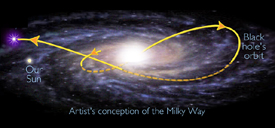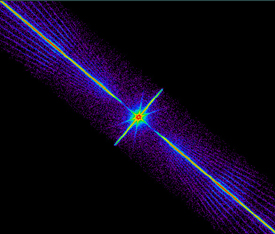
The orbit of this black hole and its companion star takes it briefly through the galactic disk — but did the pair originate in the disk or in the halo?
Courtesy I. Rodrigues and I.F. Mirabel / Space Telescope Science Institute / NRAO / AUI / NSF.
A black hole now zipping through Ursa Major might have been dropkicked out of the galactic disk by an asymmetrical supernova, astronomers reported in the June 10th Astrophysical Journal.
The black hole and its small companion star were spotted in 2000 and sparked astronomers’ interest because of their location in the galactic halo: more than 5,000 light-years above the galaxy’s disk. Stars in this area tend to be ancient leftovers from the galaxy’s early years, low in metals, which to an astronomer means any element heavier than helium.
But when a team led by Jonay González Hernández (Astrophysics Institute of the Canary Islands) turned the 10-meter Keck II telescope on the black hole and its companion star, they found something unexpected: heavy elements. The small star orbiting the black hole is soaked in heavy elements – even more-so than our Sun.
“The secondary star has an iron and metal content too high compared to stars in the galactic halo,” says González Hernández. “Despite its present location, the metal content may suggest that the system formed in the galactic disk.”
The finding lends support to an idea originally proposed by Alessia Gualandris (University of Amsterdam) and her colleagues: that the system might have been blasted out of the galactic disk when the more massive star in the binary went supernova, leaving behind a black hole and dragging its metal-rich companion along with it. But this couldn’t have been any regular supernova. To propel the system, the supernova would have been asymmetrical, like a cosmic sneeze expelling vast amounts of junk in one direction.

This Chandra X-Ray Observatory false-color image is a spectrum of the black hole system. The bright red dot in the center represents high-energy X-rays emitted by the black hole. Near the red dot, the bright white lines extending toward the upper left and lower right represent X-rays from boiling-hot gas close to the black hole. Farther away from the red dot, these line start to represent lower-energy X-rays from the accretion disk. The accretion disk is made of gas torn off the black hole”™s companion star, whose bizarre abundances of heavy elements might point to the system”™s origin.
Such a kick would have simultaneously spewed matter or neutrinos (ghostly particles that carry energy away from the core), created the black hole, and tossed the entire system out of the galaxy’s disk at about 180 kilometers per second (400,000 miles per hour). The asymmetrical kick idea was proposed years ago to explain the bizarre motions of some neutron stars, hurtling through the galaxy at speeds of up to 500 km/sec. This is only the second black hole that researchers think might have received a similar kick.
"This is an interesting system,” says Christopher Fryer, an astrophysicist at Los Alamos National Laboratory who has spent years modeling asymmetrical supernovae. "I think the results have interesting implications for our understanding of kicks. We still don’t know what is producing them.”
The supernova kick is just one hypothesis, though. González Hernández has proposed an alternative involving stellar shrapnel. If the system formed in the halo, then the supernova that created the black hole might have splattered its companion with newly formed metals, making an old halo star look relatively young.
"This would be the first such case,” says Garik Israelian (Astrophysics Institute of the Canary Islands), who was a co-author on the study. “But I think the system was kicked out from the galactic disk. This mechanism is more likely.”
The astronomers may be able to test the two hypotheses by comparing the chemical abundances of lighter elements in the companion star to those in the galactic disk and halo.
 0
0
Comments
You must be logged in to post a comment.